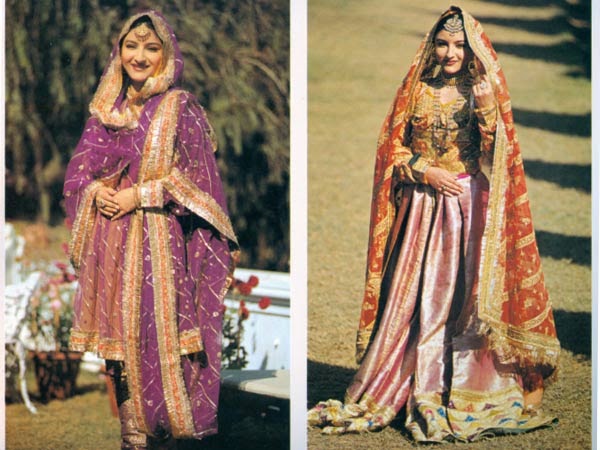Farshi Pajama
Farshi Pajama (Also Paijama)is a woman's dress that was worn between late 17th and early 20th centuries in Muslim courts of Oudh by royalty and ladies from privileged classes of Uttar Pradesh (formerly United Provinces of Agra and Oudh in North India.) Modeled after the flowing gowns worn by British noblewomen,
The complete outfit consists of three basic parts - The Kurta or a long shirt, the dupatta or the long stole which is an essential piece of cloth in traditional Indian wear covering the head and bossom, and the third and most important, the farshi pajama, which is a flowing two legged skirt held by drawstrings. It falls straight to the ankles from where it starts flaring flowing copiously onto the floor. The farshi pajama, in this era is often called Farshi Gharara, a term not used before mid 20th century and is considered a distortion. The confusion is said to be because of the Farshi Pajama's similarity with the Gharara.
Farshi means 'associated with the 'farsh' or floor' (for example farshi baithak which is associated with sitting on the floor). When combined with the word Pajama, the term evolves to mean a bottom-wear garment that falls generously on the floor, and trails as one walks, however in reality, during walking, an expert wearer holds the dress by carefully pulling up and folding the excess flaring trail and holding it in her left hand keeping the right one free which is when the dress does not trail. The large quantity (historically, 9-15 yards) of expensive cloth, embroidered using the art of goldwork (embroidery) and sterling silver wire threads (Karchob/Zari/Zardozi etc.), used to make a farshi gharara mainly reflects the grandeur and extravagance of the nobles and rulers of that era.
Modified, smaller-length versions are still, but rarely, worn by women in weddings in India and Pakistan to recreate bygone elegance.
Movies such as Umrao Jaan (1981) and Shatranj Ke Khilari (1977) that depict Muslim culture of 19th century Lucknow show noblewomen and royal courtesans wearing farshi pajamas.




EmoticonEmoticon